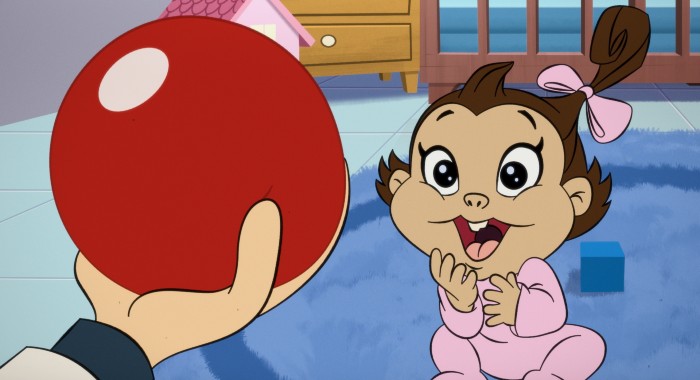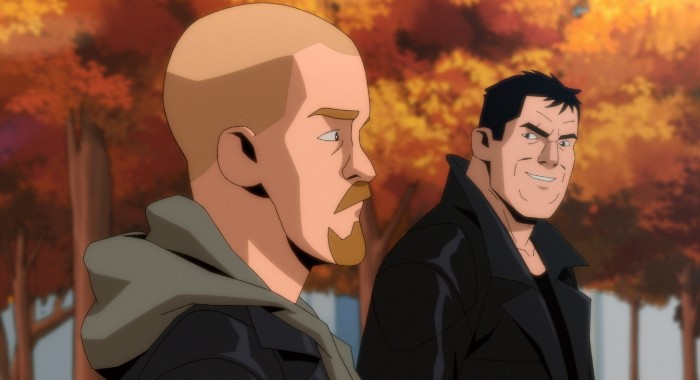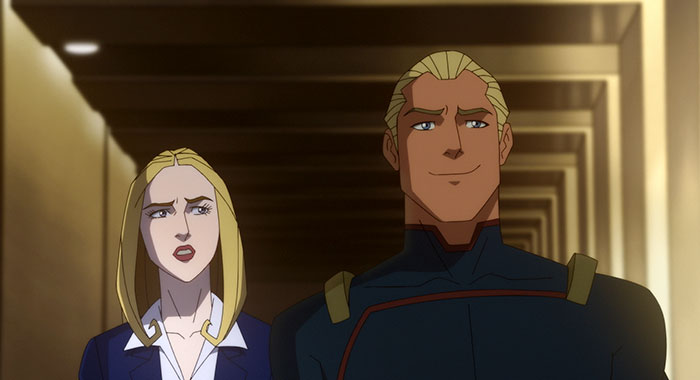TAGGED AS: Amazon Prime Video, Animation, streaming, television, TV
While we wait for season 3 of Prime Video’s The Boys on June 3, the creative minds behind the series cooked up a little something to keep fans entertained. The Boys Presents: Diabolical is that something, and by all accounts, the spinoff series expands upon the universe that Garth Ennis built all the way back in 2003 when the original comic-book series he co-created with Darick Robertson first hit shelves.
Now streaming on Prime Video, the eight-episode animated anthology features plotlines and details familiar to fans of the live-action series, but it’s not necessarily a continuation of the program. Diabolical doesn’t bridge the gap between seasons 2 and 3, instead, it opens up the story universe even further, showcasing an array of narrative possibilities. And it does so using a surprising variety of animation styles.
Each episode, which runs between 12-14 minutes-long, hails from writers like Evan Goldberg and Seth Rogen, Rick and Morty co-creator Justin Roiland, Garth Ennis, Ilana Glazer, Awkwafina, Aisha Tyler, Andy Samberg, and showrunner Simon Racioppa.
In addition to Rogen, Roiland, Awkwafina, and Samberg, the series’ voice talent includes The Boys stars Dominique McElligott, Simon Pegg, Antony Starr, Chace Crawford, Colby Minifie, Giancarlo Esposito, and Elisabeth Shue, as well as Frances Conroy, Xolo Maridueña, Caleb McLaughlin, Eugene Mirman, Retta, Ben Schwartz, Christian Slater, Kevin Smith, Kenan Thompson, Don Cheadle, John DiMaggio, Aisha Tyler, Youn Yuh Jung, Eliot Glazer, Kumail Nanjiani, Nasim Pedrad, and Ursula Taherian.
Rotten Tomatoes spoke with Racioppa to get further insight into how Diabolical came to be and the hefty process the creative team underwent to get it all done, in just 10-months time, while everyone was locked down at home.

(Photo by Prime Video)
Aaron Pruner for Rotten Tomatoes: This show comes out at an interesting time. The pandemic caused a lot of live-action productions to shut down while animation projects have ramped up. Did the shutdown cause Diabolical to go into production or was this show already planned?
Simon Racioppa: I think it’s a little bit of both. I was just wrapping Invincible, which I executive produced. Evan Goldberg and Seth Rogen are EPs on that show with me and also on The Boys. Evan approached me and said they were thinking about doing a show that could come out in time for the fans to have something before season 3, because like many shows dealing with pandemic issues, and things like that, there was gonna be a little bit of a wait. They’d always love things like The Animatrix, and things like that and they knew that we could produce animation remotely, and just get right into it and just do it.
There’s an experimental vibe to the series. Aside from The Animatrix, what else was a point of inspiration for you?
Racioppa: I also love that stuff. I also grew up watching things like Heavy Metal, which is another classic animated anthology series. Love, Death + Robots, obviously — that’s more recent. So I was like, Yeah, we can do that. We can put together a team.
Going directly from Invincible to this feels like a pretty quick turnaround. Did you ever feel rushed?
Racioppa: Basically, like Invincible, the last third of that was almost all done during the pandemic. So by that point, I had a little more experience under the belt, and we had some systems in place about how that could work. Diabolical was done entirely remotely. Everybody was remote. Everybody was working from their house. I was staring at Zoom all day for 10 months. But the team was amazing; we had great directors, great contributors, designers, artists for our outside overseas studios. Everyone really contributed and even in the middle pandemic, we were able to just hit the ground and go and make the series in 10 months.
One of the big sticking points with the series is the array of animation styles featured in each episode. How did that decision come about?
Racioppa: The conversation was on probably day 1 or day 2 of the whole production, so it was very early on. Was it to be all one style or different styles? Because obviously, all one style is much easier to produce. Every decision, you make once. What does the world look like? It looks like this. You design things once and you can add more ties to those costs and save design time across all of your episodes. That’s how a regular show like Invincible, or even the mothership The Boys is done. One style, one look across the whole thing.
But as we started talking and started thinking about what we wanted the show to be, all the different writers we were going out to, and how everybody was bringing their own voice to the show, we realized that it had to be different styles. There was no way to execute the show as well as we wanted to execute it by making it one style, because obviously, we wanted we have episodes like Awkwafina’s episode next to Andy Samberg’s, which is very dramatic, and that episode next to Justin Roiland’s off-the-wall crazy episode. I can’t think of a single unifying style that all of those would work well in. We could have shoehorned them into some kind of generic middle-of-the-road kind of style, but I don’t think it would have done the stories justice.
In not taking the easy road, and especially considering all the talent involved, did this ever turn into a herding-cats scenario?
Racioppa: On a regular series like The Boys, or like Invincible, as a showrunner, you’re bringing everybody into the tent and you’re saying, “This is what the show is.” You’re taking ideas from everybody, and you’re kind of funneling it all together and deciding on what the show is. On Diabolical, instead of bringing people in to us, we wanted to build it out to them, so we wanted to go out to Awkafina, out to Andy Samberg, and say, “What is your story in The Boys universe?” And, “How can we execute that as well as we can?” That meant different directors for every episode, different styles, different composers, different looks, different feels, different needle drops.

(Photo by Prime Video)
Without Garth Ennis, none of this would even be happening. You brought him into the fold on this for the episode, “I’m Your Pusher.” How did you get him involved and can you explain your decision to bring the old-school aesthetic from the comic book into the series?
Racciopa: It was a joy to work with him. We called him up and were like, “Hey, we’re going to do this spin-off. How would you like to write an episode, but, of the original comic? Like a lost issue, essentially a standalone story, but with your version of Butcher and your version of Hughie?” That cover that comes out of the comic book case [in the episode] is an original Darick Robertson cover we commissioned just for the show. He drew that the same way he did all the other covers for The Boys just for us. Garth was like, “Yeah that sounds great! And four days later, he emailed me the script.” We talked to him on a Thursday. And then like Sunday night, the script dropped into my inbox.
Did you hand over the keys for that episode to let him steer the ship?
Racioppa: He wrote it, it’s his world. All I helped with was trying to make sure we could produce it. So adding some little animation tweaks and things like that. Like all the writers, we kept them involved all the way through. He was involved in the casting. He saw early cuts of the designs and gave feedback.
And let’s not forget about Simon Pegg voicing Hughie – a character who was literally inspired by Simon Pegg.
Racioppa: And Simon Pegg. Yes, of course. Well, I mean, was there any other option? Who else could we get? We had to go and sign Simon. He’s a friend of the show because he’s on The Boys, so, that wasn’t even a decision; it was just, we have to get Simon Pegg. We just got him up, and he was immediately like, “Of course, I will do that. When do you need me?”

(Photo by Prime Video)
You get little bits and pieces from The Boys universe in Diabolical. Your episode, “One Plus One Equals Two,” feels the most connected to the mothership series as it deals with Homelander’s backstory. Did you feel it was pertinent here to make that narrative connection between the two projects?
Racioppa: I left my slot empty, basically, until we had all the other seven episodes sort of in place to know whether I wanted to do a dramatic episode, or something more comedic, or have a different angle that we hadn’t approached. And I was talking with Eric Kripke, who was integral to Diabolical and was there from the very start, reading, giving input and everything, and he was like, “I would love to see an early story with Black Noir and Homelander before The Seven really got put together.” So it was like, what if we do a little bit of like their first mission together? We started talking about that, and then I wrote the draft for him to give feedback on, and it just sort of came out of there.
There wasn’t an intention to connect it to the mothership. We wanted to make sure everybody was free to do their own stories. The only guidelines we gave people were that anything that was established in the mothership, we had to make true. Compound V has to be Compound V, it’s not going to be something different. Superheroes had to come from Compound V, nowhere else. Vought had to act like Vought does in the main show. Other than that, it was open. We didn’t want to constrain people with having to connect it to the mothership or not. They were able to draw from characters as they wanted to, but there are episodes like Andy Samberg’s that were able to just create whole cloth, new stuff for their episode. So it was pretty open.
With The Boys universe expanding with multiple spinoffs in development, are there any plans in place for another season of Diabolical?
Racioppa: We have lots of ideas. We’re just hoping Amazon gives us the green light, and we get to make more. I’d like to open it up even more and put in live-action segments. Just make the medium really fit the script and just open it up a lot